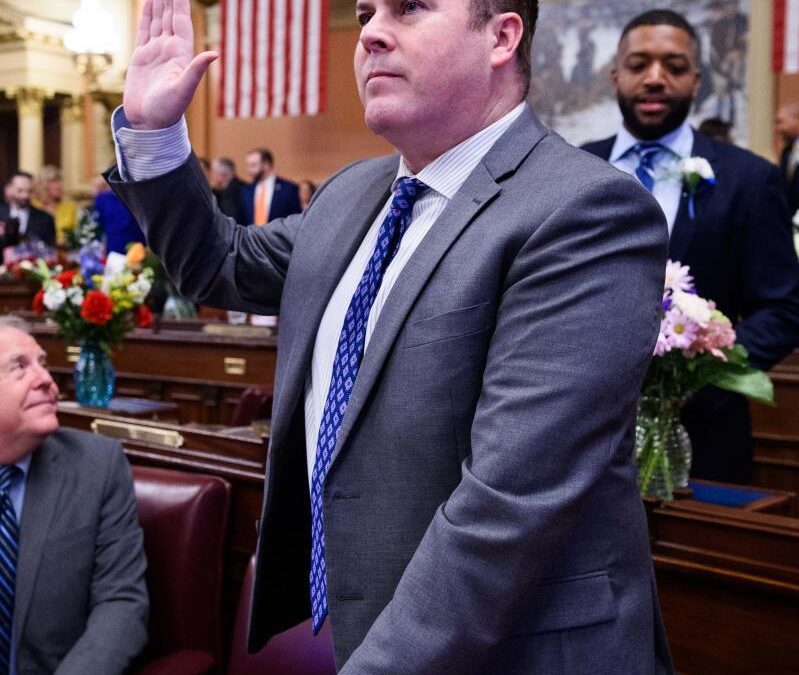
People walk along Market Street in Philadelphia. Pennsylvania got the official word from the US Census that its population growth continues to lag behind the nation's, marking the 10th consecutive decade the Keystone State has lost clout in Congress and presidential contests. (AP Photo/Matt Rourke, File)
The state will have 17 members of the US House of Representatives after next year’s election.
HARRISBURG — Pennsylvania’s population is growing. It’s just not growing enough to keep all of its presidential electors and members of Congress.
Each state’s number of presidential electors and members of the US House of Representatives are decided by population. After every census, congressional delegations can be changed to represent changing populations.
The US Census Bureau confirmed Pennsylvania’s loss of a seat in the US House of Representatives Monday, and released figures showing that Pennsylvania’s resident population crept to just over 13 million last year—13,002,700, to be precise—from 12.7 million in 2010, a gain of 2.4%.
That’s far behind the nation’s population growth of 7.4%. The lagging population growth relative to other states also could mean Pennsylvania will see a reduced share of federal money for Medicaid, social programs and infrastructure.
That’s particularly bad news for the state’s growing transportation needs amid a deepening stalemate over financing its highways and public transit.
Gov. Tom Wolf has proposed phasing out Pennsylvania’s gasoline tax, the second-highest in the nation, as his Department of Transportation looks to impose tolls on up to nine major bridges to help close a construction and maintenance budget gap that is roughly $8 billion per year—and growing.
That gap is more than half the $15 billion that is needed annually to keep Pennsylvania’s highways and bridges in good condition and ease major traffic bottlenecks, PennDOT officials say.
Pennsylvania’s Congressional Delegation
Pennsylvania’s delegation reached a height of 36 in 1913 and stayed that large for two decades. Since then, however, it has dropped every decade.
The Keystone State isn’t the only one to lose members. California, Illinois, Michigan, New York, Ohio, and West Virginia also lost seats. Meanwhile, Colorado, Florida, Montana, North Carolina, and Oregon will add one seat. Texas will add two more.
That means Pennsylvania will continue to have the fifth most electoral votes and members of Congress.
But it will mean one of our state’s US Representatives will soon be without a district.
Pennsylvania will have 17 US House seats for 18 incumbent US House members when next year’s elections roll around. That raises the question of whose district will disappear and whose political career could be upended.
A new map of districts must win approval from the Republican-controlled Legislature and Wolf, a Democrat, and the districts they draw could have a dramatic effect on the political careers of the state’s 18 US House members.
If each of the 18 wants to run for another term in Congress, two of them will have to run against each other.
A new map is necessary before it is time to circulate petitions to get on next year’s primary ballot. If Wolf and lawmakers can’t agree on one, the state Supreme Court will do it for them.
What makes Republicans nervous is that the state Supreme Court has a 5-2 Democratic majority. The most practical place to eliminate a district is where the population is stagnant: largely Republican areas in northern and western Pennsylvania.
Redistricting data necessary to draw districts that are equal in population—they include counts of population by race, Hispanic origin, gender, and housing at geographic levels as small as neighborhoods—isn’t expected to be released by the Census Bureau until late August, at the earliest.
Who’s Running for Reelection to Pennsylvania’s Congressional Delegation
Of particular interest is speculation that a member of Congress—if not several—will run for higher office and thus reduce the number of incumbents lobbying state lawmakers for favorable district lines.
In next year’s election, Pennsylvania has two attractive lures for ambitious politicians: an open US Senate seat and a wide open governor’s race, with Wolf termed out.
So far, second-term Republican Rep. Dan Meuser of Luzerne County has said he is interested in running for governor, while Democratic Reps. Conor Lamb of Allegheny County and Chrissy Houlahan of Chester County have said they’ll consider running for US Senate.
Typically, partisan map-drawers strive to give each incumbent of their party a district where they live and have at least a reasonable shot at winning another term.
If an incumbent decides to retire or run for higher office, map-drawers become far more likely to eliminate that district, or at least substantially change it to accommodate the wishes of incumbents who plan to run again.
Politics

Philadelphia DA cancels arrest warrant for state Rep. Kevin Boyle on eve of Pa. primary
Philadelphia District Attorney Larry Krasner said a detective had sought the warrant against Boyle, a Democrat whose district includes a section of...

Influencers and creators find new ways to engage young Philadelphia voters
Rec Philly, a space for creators and influencers, teamed up with Show Up Strong to get hundreds of young Philadelphia residents engaged in the...

New Biden rule protects privacy of women seeking abortions
Under the new rules, state officials and law enforcement cannot obtain medical records related to lawful reproductive health care with the goal of...
Local News

Conjoined twins from Berks County die at age 62
Conjoined twins Lori and George Schappell, who pursued separate careers, interests and relationships during lives that defied medical expectations,...

Railroad agrees to $600 million settlement for fiery Ohio derailment, residents fear it’s not enough
Norfolk Southern has agreed to pay $600 million in a class-action lawsuit settlement for a fiery train derailment in February 2023 in eastern Ohio,...





